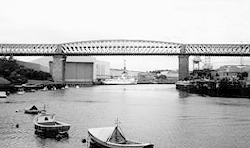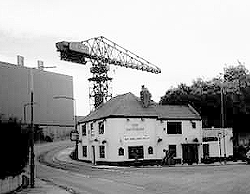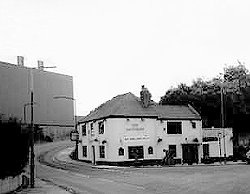Prior to the Thatcher years, Sunderland was long a thriving centre of coal mining and export, but the city was better known in recent years for its shipbuilding industry.

Queen Alexandra Bridge spanning what was
the heart of the shipyards on the river Wear
Thomas Menville is recorded to have built ships in Sunderland as early as 1346, but shipbuilding is believed to have taken place much earlier than this.
Back in 1885, a primitive ‘dug-out’ canoe was found in the River Wear near Hylton in the northwest of the city. The canoe is believed to date from around 2,000 years ago and is claimed to be the earliest example of Sunderland shipbuilding.

The Saltgrass public house with evidence
of a crane still standing from
the shipbuilding industry
(picture taken November 2000)

The Saltgrass public house today after
demolition of above crane
By 1814, Sunderland had 24 shipyards on the banks of its river; this figure had risen to 65 in 1840. By the middle of the 20th century, Sunderland was producing over a quarter of the nation’s total shipbuilding output for the national effort in World War Two and was the largest shipbuilding town in the world.
As part of Margaret Thatcher’s determined effort to bring the British manufacturing industry to its knees in the 1980s, the shipyards suffered and gradually disappeared from the Sunderland stretch of the River Wear. Despite a massive, widely supported campaign, Thatcher eventually got her way in 1988 when the final shipyard in the once largest shipbuilding town in the world closed its doors and thousands more joined the lengthy Sunderland dole queue.
